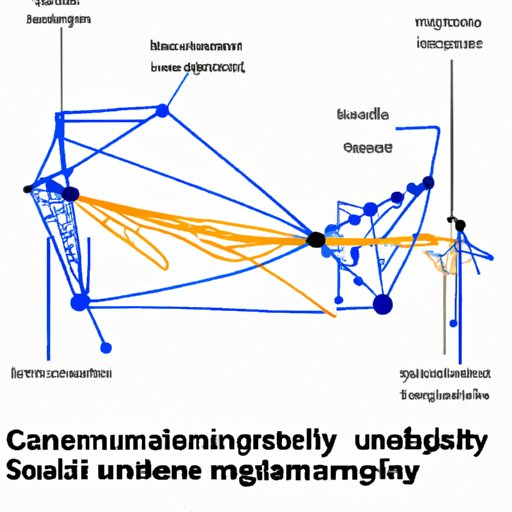Introduction
Uncertainty is a common feature of scientific research. It is the inherent lack of certainty that exists when studying complex phenomena and attempting to draw conclusions from observed data. This article will explore the nature of uncertainty in science and examine the various factors that contribute to it. We will also discuss the implications of uncertainty for scientific research and suggest ways to address it.

Exploring the Nature of Uncertainty in Science
Uncertainty in science arises from a variety of sources. It is often caused by limitations in the methods used to collect and analyze data, as well as by gaps in knowledge or conflicting evidence. These factors can make it difficult to draw definitive conclusions from scientific research.
Causes of Uncertainty in Scientific Research
The causes of uncertainty in scientific research vary depending on the type of study being conducted. Some of the most common sources of uncertainty include:
- Inadequate sample sizes or data sets
- Inaccurate or incomplete data collection techniques
- Inconsistent results across different studies
- Insufficient understanding of the phenomenon being studied
- Limited resources for conducting research
Types of Uncertainty in Scientific Research
Uncertainty in scientific research can be divided into two broad categories: epistemic uncertainty and aleatory uncertainty. Epistemic uncertainty refers to uncertainty caused by gaps in knowledge or incomplete information, while aleatory uncertainty refers to uncertainty caused by randomness or variability in the system being studied.
Examining the Role of Probability and Statistics in Scientific Research
Probability and statistics are important tools for measuring and managing uncertainty in scientific research. By using probability and statistical models, researchers can quantify the likelihood of certain outcomes and gain insights into the magnitude and direction of potential effects.
Use of Probability and Statistics to Measure Uncertainty
Probability and statistics can be used to measure the amount of uncertainty in a given situation. For example, researchers may use the standard deviation of a set of data points to determine how much the individual values are likely to deviate from the mean. They may also use probability distributions to estimate the likelihood of certain outcomes occurring.
Impact of Probability and Statistics on Scientific Results
The use of probability and statistics in scientific research can have a significant impact on the results of a study. By quantifying the amount of uncertainty in a given situation, researchers can better understand the implications of their findings and draw more meaningful conclusions from their data.

Investigating the Impact of Measurement Error on Scientific Results
Measurement error is another source of uncertainty in scientific research. It occurs when the measurements taken during a study are inaccurate or imprecise. This can lead to errors in the data collected and can affect the accuracy of the results.
Sources of Measurement Error
Measurement error can arise from a variety of sources. Common sources of measurement error include faulty equipment, incorrect data recording, and inadequate sampling techniques. In addition, environmental factors such as temperature and humidity can also affect the accuracy of measurements.
Consequences of Measurement Error
Measurement error can have serious consequences for scientific research. Incorrect measurements can lead to inaccurate results, which can in turn lead to incorrect conclusions being drawn from the data. Additionally, measurement error can lead to increased uncertainty in the results of a study, making it more difficult to draw reliable conclusions.
Analyzing the Influence of Human Judgment on Scientific Decisions
Human judgment plays an important role in scientific research, as it is often necessary for researchers to make decisions about how to interpret and use the data they have collected. However, human judgment can also introduce uncertainty into the process, as it is subject to bias and other personal factors.
Examples of How Human Judgment Influences Scientific Decisions
Human judgment can influence scientific decisions in many ways. For example, researchers must decide which data points to include or exclude from their analysis, which hypotheses to test, and which conclusions to draw from their results. Additionally, researchers must often make decisions about how much uncertainty to accept in their results and whether to pursue further research.
Potential Risks Associated with Relying on Human Judgment
Relying on human judgment to make scientific decisions can be risky, as it can lead to subjective interpretations of the data and erroneous conclusions. Additionally, relying too heavily on human judgment can lead to confirmation bias, where researchers look for evidence to support their preconceived notions rather than objectively evaluating the data.
Understanding the Implications of Modeling and Simulation in Science
Modeling and simulation are powerful tools for exploring complex phenomena and predicting the behavior of systems. They can be used to test hypotheses and gain insights into the dynamics of a given system. However, like any tool, they can also introduce uncertainty into scientific research.
Benefits of Modeling and Simulation in Scientific Research
Modeling and simulation offer numerous benefits for scientific research. They allow researchers to explore the behavior of complex systems without having to conduct expensive and time-consuming experiments. Additionally, they can provide insights into the behavior of systems that would not be possible through traditional experimentation.
Limitations of Modeling and Simulation
While modeling and simulation can be useful tools for exploring complex phenomena, they are not without their limitations. Models are often limited by the data available, and simulations can be affected by errors in the underlying assumptions. Additionally, there is always some degree of uncertainty associated with the results of modeling and simulation due to the inherent complexity of the systems being studied.

Evaluating the Effects of Unknown Variables in Scientific Research
Unknown variables are another source of uncertainty in scientific research. Unknown variables are factors that are not directly measured or accounted for in a study, but which may still have an effect on the results. Identifying and managing these variables is essential for drawing reliable conclusions from scientific research.
Identifying Unknown Variables
Identifying unknown variables can be challenging, as they are not always easy to spot. Researchers must carefully consider all potential sources of variability and identify any factors that could potentially influence the results of the study. This includes both known and unknown variables.
Managing the Effects of Unknown Variables
Once unknown variables have been identified, researchers must take steps to manage their effects. This may involve increasing the sample size or collecting more detailed data to account for potential variability. Additionally, researchers should strive to reduce sources of bias and speculation in order to ensure that their results are as accurate as possible.

Examining the Role of Interdisciplinary Collaboration in Addressing Complexity in Science
Interdisciplinary collaboration is increasingly being used to address the complexity of modern scientific research. By bringing together experts from different fields, researchers can gain insights into the underlying dynamics of complex systems and draw more reliable conclusions from their data.
Benefits of Interdisciplinary Collaboration
Interdisciplinary collaboration offers numerous benefits for scientific research. By combining the knowledge and expertise of multiple disciplines, researchers can gain a deeper understanding of the phenomena they are studying. Additionally, interdisciplinary collaborations can help to reduce the amount of uncertainty in a study by providing multiple perspectives on the data.
Challenges of Interdisciplinary Collaboration
Despite its potential benefits, interdisciplinary collaboration can also present challenges. Communication between researchers from different disciplines can be difficult, and conflicts in methodology and interpretation can arise. Additionally, coordinating research efforts between multiple groups can be time-consuming and expensive.
Conclusion
Uncertainty is a common feature of scientific research. It can arise from a variety of sources, including inadequate sample sizes, inaccurate measurements, and gaps in knowledge. Additionally, human judgment, modeling and simulation, and unknown variables can all contribute to uncertainty in scientific research. By understanding the nature of uncertainty and taking steps to address it, researchers can increase the reliability of their results and draw more meaningful conclusions from their data.
(Note: Is this article not meeting your expectations? Do you have knowledge or insights to share? Unlock new opportunities and expand your reach by joining our authors team. Click Registration to join us and share your expertise with our readers.)
